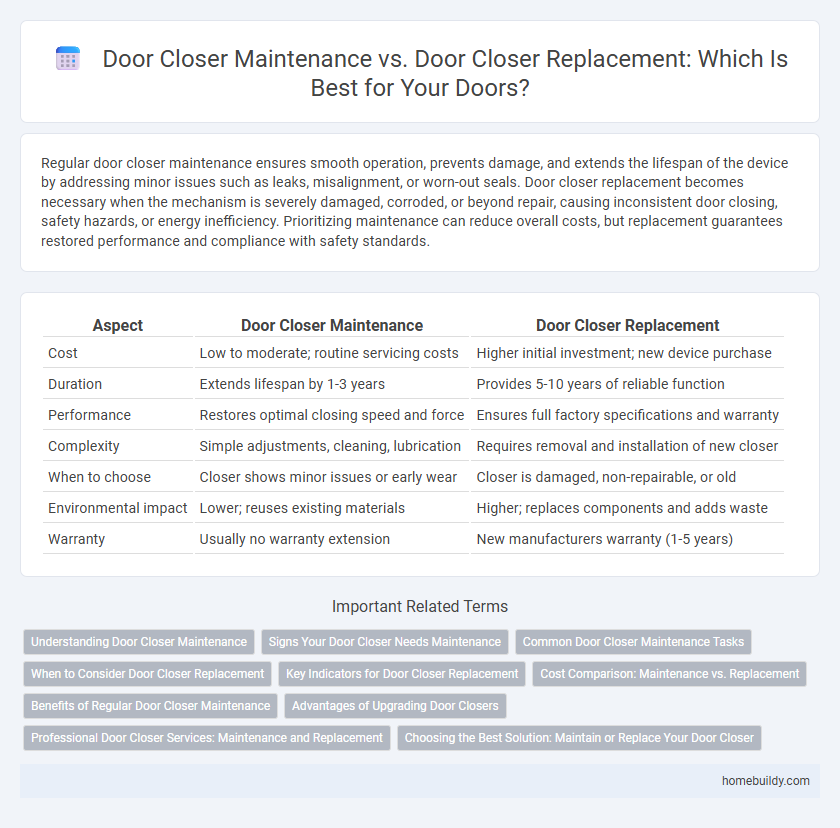Regular door closer maintenance ensures smooth operation, prevents damage, and extends the lifespan of the device by addressing minor issues such as leaks, misalignment, or worn-out seals. Door closer replacement becomes necessary when the mechanism is severely damaged, corroded, or beyond repair, causing inconsistent door closing, safety hazards, or energy inefficiency. Prioritizing maintenance can reduce overall costs, but replacement guarantees restored performance and compliance with safety standards.
Table of Comparison
| Aspect | Door Closer Maintenance | Door Closer Replacement |
|---|---|---|
| Cost | Low to moderate; routine servicing costs | Higher initial investment; new device purchase |
| Duration | Extends lifespan by 1-3 years | Provides 5-10 years of reliable function |
| Performance | Restores optimal closing speed and force | Ensures full factory specifications and warranty |
| Complexity | Simple adjustments, cleaning, lubrication | Requires removal and installation of new closer |
| When to choose | Closer shows minor issues or early wear | Closer is damaged, non-repairable, or old |
| Environmental impact | Lower; reuses existing materials | Higher; replaces components and adds waste |
| Warranty | Usually no warranty extension | New manufacturers warranty (1-5 years) |
Understanding Door Closer Maintenance
Regular door closer maintenance extends the lifespan and ensures optimal performance by preventing common issues like oil leakage, mechanical wear, and misalignment. Routine inspections and adjustments help maintain proper closing speed and latching force, reducing the risk of door damage or security breaches. Understanding door closer maintenance allows for cost-effective solutions that delay the need for full door closer replacement.
Signs Your Door Closer Needs Maintenance
Signs your door closer needs maintenance include difficulty in closing or latching doors properly, unusual noises such as squeaking or grinding, and visible oil leakage indicating hydraulic fluid loss. Warped or misaligned doors causing uneven pressure on the closer also signal the need for professional inspection and timely servicing. Regular maintenance extends the lifespan of door closers, preventing premature replacement costs and ensuring smooth, secure door operation.
Common Door Closer Maintenance Tasks
Common door closer maintenance tasks include lubricating moving parts, adjusting closing speed and latching force, and inspecting for wear or damage to hinges and seals. Regular maintenance extends the lifespan of door closers by preventing misalignment, reducing noise, and ensuring smooth operation. When frequent repairs are needed or parts become irreparable, door closer replacement becomes a more cost-effective and reliable solution.
When to Consider Door Closer Replacement
Door closer replacement should be considered when the device shows persistent issues such as leaking hydraulic fluid, inability to control closing speed, or damaged internal components that cannot be repaired. Frequent maintenance costs and recurring malfunctions indicate that replacement will be more cost-effective and ensure consistent door operation. Professional assessment of the door closer's condition can help determine whether repair or replacement best maintains safety and functionality.
Key Indicators for Door Closer Replacement
Key indicators for door closer replacement include persistent leaks in the hydraulic fluid, significant delays or slamming during door closing, and visible damage to the closer body or arm. If the door closer fails to maintain proper door alignment or requires frequent adjustments, replacement is often more cost-effective than maintenance. Worn-out components causing inconsistent closing speed or compromised security also signal the need for immediate replacement.
Cost Comparison: Maintenance vs. Replacement
Door closer maintenance typically costs between $50 and $150 per service, extending the lifespan of the device by addressing minor issues like oil leaks or misalignment. Replacement expenses range from $150 to $500, including the cost of a new door closer unit and professional installation. Opting for maintenance can be more cost-effective long-term, but frequent breakdowns may justify replacement to avoid higher cumulative repair costs.
Benefits of Regular Door Closer Maintenance
Regular door closer maintenance ensures consistent closing performance, reduces wear and tear, and extends the lifespan of the device. Preventative care minimizes costly repairs and helps maintain security by preventing door malfunctions. Properly maintained door closers preserve energy efficiency by ensuring doors close tightly, reducing air leakage in commercial and residential buildings.
Advantages of Upgrading Door Closers
Upgrading door closers enhances security by ensuring consistent, smooth operation and reduces the risk of malfunction compared to frequent maintenance. Modern door closers offer improved energy efficiency and compliance with updated building codes, contributing to lower long-term costs. Advanced models also provide customizable closing speeds and stronger durability, minimizing wear and extending service life.
Professional Door Closer Services: Maintenance and Replacement
Professional door closer services offer comprehensive maintenance to extend the lifespan and ensure smooth operation of door closers, preventing costly damage and enhancing safety. Regular maintenance includes lubrication, adjustment, and inspection of components to optimize performance and avoid premature failures. When wear or damage exceeds repairable limits, skilled technicians provide door closer replacement with high-quality models tailored to the specific door type and usage requirements.
Choosing the Best Solution: Maintain or Replace Your Door Closer
Evaluating door closer maintenance versus replacement requires assessing functionality, cost, and longevity. Maintaining a door closer involves lubrication, adjustments, and minor repairs to extend its lifespan and ensure smooth operation, typically costing less than replacement. If frequent breakdowns, corrosion, or outdated mechanisms persist, replacing the door closer with a modern, energy-efficient model provides enhanced security, compliance, and long-term savings.
Door closer maintenance vs Door closer replacement Infographic

 homebuildy.com
homebuildy.com